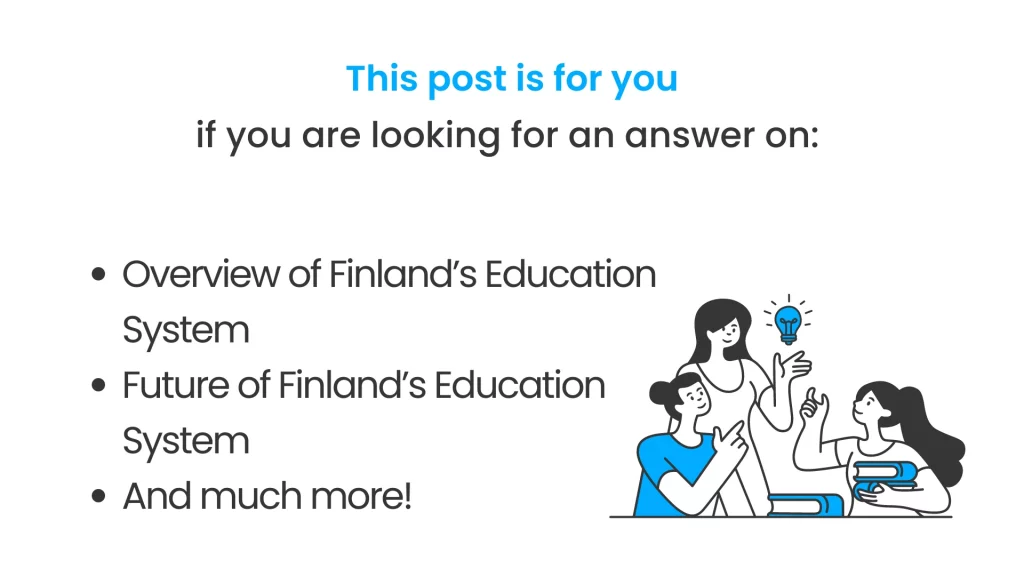Are you curious about what makes Finland’s education system so highly regarded? Look no further! Finland’s education system is known for its equal opportunities, focus on student well-being, and innovative approach to learning.
In Finland, education is free for all and the government provides comprehensive support for students, including free meals and transportation. The small class sizes and highly trained teachers work together to foster a learning environment that emphasizes creativity, critical thinking, and collaboration. Plus, students are encouraged to take an active role in their own education and are supported in their academic and personal growth.
Do you know?
The number of non-European student applications increased by 141%, and 93% successfully entered the country in 2021.
So, what are you waiting for? Get ready to dive into the fascinating world of the Finnish education system. Whether you’re a student, parent, or education professional, you’ll come away with a new appreciation for what makes a successful and effective education system.
Topics covered
What all is covered in this post?
This blog will help you by providing a better understanding of the following aspects:

Overview of Finland’s Education system
Studying in Finland holds a lot of opportunities. In this section, we will discuss the benefits of Finland’s education system.
| Characteristic | Description |
| Free and equal access to education | Education is free for all, and there is no private school system, ensuring equal access to high-quality education for all students. |
| Focus on student well-being | The education system places a strong emphasis on student well-being, including physical activity, time spent outdoors, and mental health. |
| Small class sizes and highly trained teachers | Classes are small in size, and teachers are highly trained professionals who work closely with students. |
| Holistic approach to learning | The education system takes a holistic approach to learn, emphasizing creativity, critical thinking, and collaboration. |
| Active role for students | Students are encouraged to take an active role in their own learning and are supported in their academic and personal growth. |
| Emphasis on equality | Equal access to education is seen as a cornerstone of Finnish society and has contributed to the country’s high level of social and economic development. |
| Comprehensive support for students | The government provides comprehensive support for students, including free meals and transportation. |
| Innovative approach to education | The education system is known for its innovative approach, using modern pedagogical methods and technologies to improve the learning experience for students. |
Finland Education System
Finland’s education system includes nine years of compulsory basic education, early childhood education and care, pre-primary education, upper secondary education, higher education, and finally adult education. A description of all these levels is given below.
Early childhood education
Early childhood education refers to the education and care of children under the age of seven. In Finland, this stage of education is not compulsory, but it is widely available and free of charge.
Preschool
Preschool, also known as kindergarten, is the education and care of children between the ages of seven and six. This stage of education lays the foundation for formal education and focuses on the child’s overall development, including social skills, physical skills, and language development.
General education
General education is a nine-year compulsory education that all children in Finland receive. At this stage, students receive a broad education that prepares them for further studies or work.
Secondary education
Secondary education in Finland is divided into lower secondary and upper secondary education. Lower secondary education is a three-year stage that follows comprehensive education, while upper secondary education gives students the opportunity to specialize in a particular field of study.
Vocational Education
Vocational education is a form of education that provides students with the skills and knowledge needed for careers in specific fields such as construction, business, and health care.
Preparatory education for programs leading to upper secondary education
Preparatory education is a year-long program that provides students with the skills and knowledge needed to complete upper secondary education and gain qualifications at a higher level.
Future of Finland’s education system
The future of Finland’s education system is expected to continue to evolve and adapt to meet the changing needs of students and society. Here are some key facts about the future of the Finnish education system:
- Emphasis on digital learning: The Finnish education system is expected to place increasing emphasis on digital learning and technology, with an emphasis on incorporating digital tools and methods into teaching and learning.
- Increasing internationalization: It is expected that the Finnish education system will continue to internationalize with increased cooperation and exchange programs with other countries.
- Greater emphasis on lifelong learning: The Finnish education system is expected to place greater emphasis on lifelong learning, recognizing that learning is a continuous process that goes beyond the formal education system.
- Focus on sustainable development: It is expected that the Finnish education system will continue to place a strong emphasis on sustainable development and the role of education in promoting sustainable development.
- Expansion of vocational education: The Finnish education system is expected to continue to expand vocational education, recognizing its important role in preparing students for the world of work.
- Personalized and student-centered learning: The Finnish education system is expected to continue to promote personalized and student-centered learning, giving students more control over their own learning and development.
- A strong focus on equality: Finland’s education system is expected to continue to have a strong focus on equality, ensuring that everyone has access to high-quality education, regardless of their background or circumstances.
With advantages there come disadvantages also, so here are…
Challenges of Finland’s education system
Here are some of the challenges facing the Finnish education system:
- Funding constraints: Despite being well funded, the Finnish education system faces funding constraints and must operate within a limited budget.
- Attracting and retaining qualified teachers: Attracting and retaining qualified teachers is a challenge for the Finnish education system, as teaching is a highly competitive and demanding profession.
- Meeting the needs of students with special needs: Meeting the needs of students with special needs, such as those with disabilities or learning difficulties, is a challenge for the Finnish education system.
- Keeping up with technological change: Keeping up with the rapid pace of technological change is a challenge for the Finnish education system, as new technologies and teaching methods are constantly being developed.
- Improving student engagement and motivation: Increasing student engagement and motivation, especially in the early stages of learning, is a challenge for the Finnish education system.
- Maintaining the quality of education: Maintaining a high quality of education in the face of increasing demand for educational services and limited resources is a challenge for the Finnish education system.
- Preparing students for a changing world of work: Preparing students for a changing world of work and equipping them with the skills and knowledge they need to succeed in a rapidly changing economy is a challenge for the Finnish education system.
It’s a wrap!
The Finnish education system is focused on equality for all. International students can certainly benefit from this privilege. They will definitely get the best higher education while studying in a modern, world-class country!
Sign up for a free consultation now and we’ll start your journey to the best higher education in the world! Be the best version of yourself and become globally competitive! iDreamCareer is the perfect solution. With a team of experienced counsellors, we provide personalized guidance to students at every step of the way. From finding the right program and university to preparing your application and building your profile (which is free of cost), iDreamCareer’s experts will help you achieve your study abroad goals. If you are looking to study abroad, visit iDreamCareer.com today and take the first step toward your dream career.
We have helped several brilliant but confused minds with the aim to select their most-suited career choices. Hear the success story of Aayush who got an offer from the top 3 universities and is now studying at the University in Ottawa in Canada after getting career guidance from our industry experts!
Useful Links:
- Study in Europe
- IELTS Exam Pattern
- IELTS Syllabus
- Study in UK without IELTS
- Affordable countries to study abroad
- How to get scholarships abroad
- Best Countries to Study Abroad
- Japan Education System
Finland Education System: FAQs
Finland ranks third in the country’s education ranking in 2021 with a total score of 1.631K. Finland has the world’s highest high school graduation rate. According to the Global Competitiveness Report of the World Economic Forum, Finland has the most developed education system in the world.
While studying in most countries will require you to fork out often high tuition fees, Finland has somehow managed to keep university education fully funded by the state – even for international students. There are a few exceptions: some Master’s courses charge fees to non-EU/EEA students.
English is the second language of most Finns. Official statistics from 2012 show that at least 70% of Finnish people speak English.
Generally, the school day in a Finnish school starts between 9 and 9:45 a.m. and students usually spend about five hours a day in the classroom. Moreover, Finnish students usually have almost no homework.
As an Indian student who wants to study in Finland, you need to have a valid passport and visa to enter the new country. A single-entry visa allowed one-time entry into the Schengen area for up to 90 days in any 180-day period, while a double-entry visa doubled the entry time.

Anushree Rastogi is a Senior Content Writer at iDreamCareer, bringing over 5 years of expertise to the field of career counseling. She has done a PGDM in Marketing and Finance and possesses a unique blend of skills that allows her to craft engaging and informative content. She is passionate about helping individuals navigate their career paths and has dedicated her career to providing valuable insights through her content. Her commitment to excellence and keen understanding of the career landscape make her a trusted guide for those seeking professional direction. With a flair for clear and engaging writing, Anushree is on a mission to empower others to make informed and fulfilling career choices.










